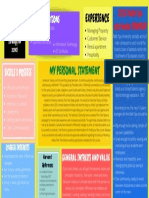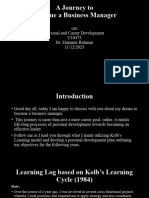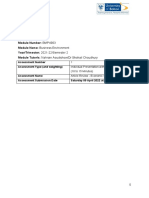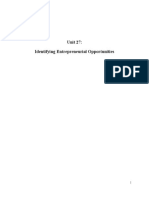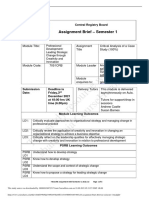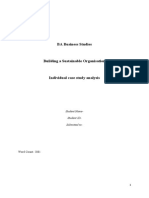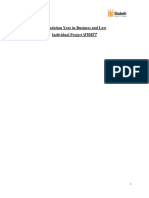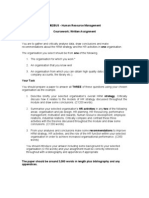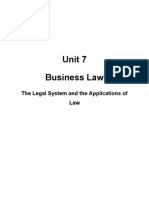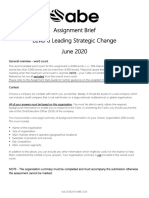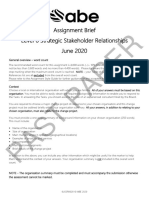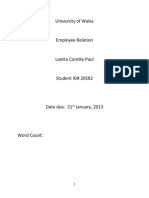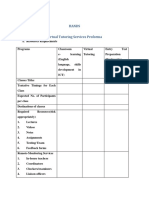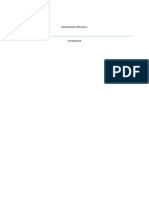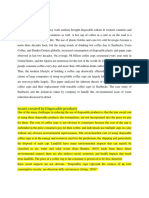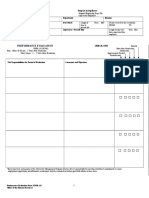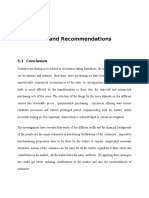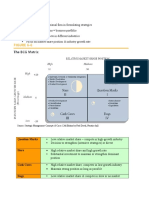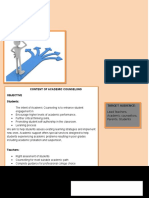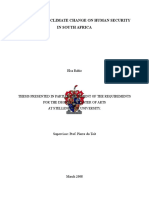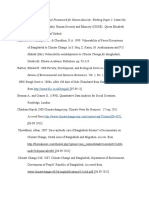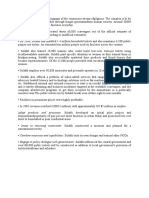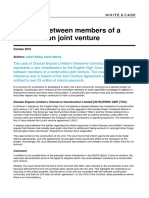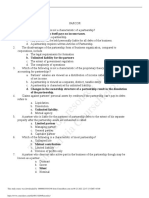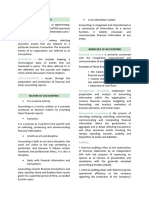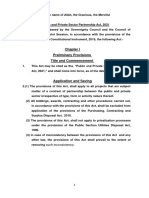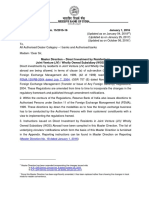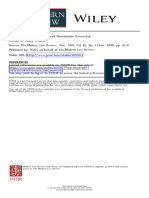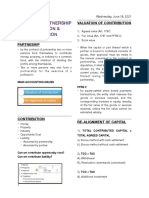Introduction
Human Resource Management (HRM) is an essential instrument to reach an organization's
strategic goals. As stated by Banfield and Kay (2008) HRM is an approach to the management of
employees that seeks to achieve the organization's strategic goals through the development, and
well-being of a key resource it poses - people.
The organization I will study for the purpose of this assignment is John Lewis Partnership (JLP),
which owns leading UK retail business. All 69,000 permanent employees are partners and
ensuring "the happiness of all JLP members, through their worthwhile, satisfying employment in
a successful business" (JLP handbook 2009, p.5) is at the centre of everything the Partnership
does. HRM department at JLP is responsible for the wellbeing of all partners from the
recruitment and selection process, and trough out their career development.
Through this assignment I will examine how HRM in the John Lewis Partnership contributes to
the Partnership organizational goals by identifying three HRM activities and their objectives,
also justifying how these objectives were achieved by effective management of human resources.
In order to support this I will relate two HRM models to JLP. In addition, I will examine three
HR planning and development methods, and critically evaluate their effectiveness to reach the
Partnership objectives. Finally, I will analyze ways in which HR performance maybe improved
through critically reviewing how the performance of HR in the Partnership is monitored, and will
give suggestion for improvement.
Contribution of HRM to achieve JLP goals
Three activities of HRM in the John Lewis Partnership are:
Reward - Benefits
Employee voice - Partnership council
Welfare services - Occupational health
HRM activities' objectives, and achievement of these through effective management of HR
in the John Lewis Partnership
Benefits
Benefits are a kind of remuneration, additional to the cash pay in any employment. (Armstrong,
2003).
The objective of the benefit package offer by JLP is reward partners when they are successful,
and protect their physical and mental well being (Partnership Handbook 2009).
�In order to achieve the above, HRM department has created a wide package of benefits, some of
them fix such as Partnership bonus. Each year the profit made on the previous trading year is
announce, JLP separates the funds needed to develop the business, and the rest is shared among
partners, which is a percentage of the pay for that particular trading year, so partners enjoy the
rewards of their own success. HRM at the Partnership also deals with Partnership discount,
which is substantial - 25% in purchases on John Lewis stores, and 15% in Waitrose - ;
encouraging partners, and member of their house hold to shop in the business, increasing sales
that will help to achieve monetary targets.
Some of the benefits offered by JLP are flexible, these include PartnerChoice. PartnerChioce
includes leisure activities organized locally by every branch or special events organized by the
head office; discount in restaurants, cinemas, hotels, and services such us mobile provider, and
car repair services, to mention some. All these contribute to a work-life balance that helps
partners to keep their enthusiasm at work, leading to achieve JLP goals.
Employee Voice - Partnership Council
Employee voice is one of the employee involvement (EI) practices, which empowers employees
to contribute to decision making in an organization (Boxall and Purcell, 2003).
In JLP employee voice takes the shape of Partnership Council, which main objective is to share
the responsibilities of ownership, as well as its rewards - profit, knowledge and power-,
representing all partners and reflecting their opinion (Partnership Constitution, 2009).
Democracy is at the heart of JLP. Every branch of the business has a representative or councillor
elected by the partners of that particular branch; any partner can stand for election, and also has
the right to vote. "The council has the right to discuss, to ask questions, and to make
recommendations on any subjects it wishes" (JLP intranet), also it holds the Chairman to
account. Among all the topics that partners have influenced the Partnership Board decisions
trough the partnership council are: branch opening hours, changes in partnership discount (from
12% to 15% in Waitrose), and review of JLP strategy, bringing ideas from all part of the business
to ensure JLP is fit for the future. (The Gazette, vol. 91, #22, 2009).
Occupational Health
According to the World Health Organization (WHO) (1950; cited by Gilmore and Williams,
2009) occupational health is the promotion and maintenance of wellbeing of HR through illness
prevention, risk controlling, and adjustment of the work environment to people, and people to
their work environment.
The objective of occupational health in JLP is to provide advice to all partners on health, and
safety within the work place, for their benefit and the Partnership's. (JLPnet - Intranet site)
The above is achieved through advising on health issues raised at recruitment, and making
necessary adjustments to ensure that will not be harmed by their work. In every branch there is a
group of health professional, nurse, physiotherapist and podiatrist, who evaluate risks and make
�workplace inspections, in order to identify dangerous working conditions or practices, and base
on this make suggestion for improvement (Partnership handbook, 2009). For example, all JLP
computer users receive a work station assessment by the physiotherapist, where she identify the
right kind of chair for the particular partner, if feet support is needed, the right high for the
screen, among other issues. In the same way, selling partners are asses by the podiatrist who will
recommend the right kind of footwear. This encourages partners to be comfortable at work,
which help them to fulfill their duties.
Two HRM models partially applied at JLP are:
Karen Legge (1995) model seems to be present in the Partnership HRM because within JLP
flexibility, numerical and functional, is practiced. In one hand, numerical flexibility is use as
"The Partnership is committed to provide the best work life balance possible to all partners...
[who] are able to make a request for flexible working" (Partnership Handbook, 2009). In
addition to part time post, partners can make arrangement to decrease their contractual hours, or
change working patterns, if their personal circumstances change (due to health or family issues,
studies etc.); take unpaid leave without losing benefits, or work from home (if the duties for a
particular job may be achieved out of site). On the other hand, functional flexibility is developed
through training partners in different aspects of the business, in addition to the training they need
to do their particular job. Such is the case of till training, all partners are encouraged to undergo
till training in order to support their branch at particular times e.g. Christmas, especial
promotions, sale periods.
The Partnership encourages empowerment in a direct way, as owners of the business partners not
just share the profits, but also the responsibility of the business successes and failures. JLP
support partners to make decisions on the spot as difficult situation may arise, as well as develop
new ideas to improve the business.
Another model partially developed at JLP is the John Storey (2001) model. HR is at the centre of
the Partnership, as stated in JLPnet "the happiness of partners is at the centre of everything we
do". From the moment of recruitment, and during all the employment in JLP, partners are
reminded of the importance of their role in the Partnership independent of the position they hold.
Through informal meetings, weekly communication meetings, and internal publications, such as
the Gazette (Partnership wide), or the Chronicle (local branch magazine), to mention few,
partners are constantly reminded that the most valuable asset in the partnership is the people, and
are encourage to their potential to achieve personal satisfaction, and at the same time help the
business achieve its goals.
In the Partnership HRM is not left to personnel specialist alone, line managers are trained in
different aspects of HRM. From recruitment, line managers deal with HR, conducting second
interviews, later planning training paths for all partners under their wing. Line managers also are
concerned with attendance and pay, being in charge of PartnerLink, the system use for these
matters; they are also who conduct the Annual Review of Performance (ARP) to evaluate
partners performance. These are just some of the HRM responsibilities line managers assume
when working for JLP.
�Three HR planning and development methods at John Lewis Partnership are:
HR planning method
According to Foot and Hook (2003) HR planning is a way to prepare an organization to deal with
future HR requirements in order to achieve strategic goals.
Recruitment
A way of recruitment at JLP is E-recruitment. External vacancies are advertised on the
Partnership's vacancies website www.jlpjobs.com. Applicants fill an online questionnaire, which
simultaneously creates a personal application centre, where they can monitor the status of their
application; if the applicant meet the requirement for that particular vacancy, he/she is ask to
book an interview via the personal application centre previously set . Internal vacancies are
accessible to partners through JLP intranet, partners are able to apply to any vacancy, whether
external or internal, in any of the divisions of the Partnership, an unlike external applicants,
partners just have to fill up personal details, including present position, and write statement
instead of a full questionnaire.
HR development methods
As defined by Armstrong (2002) HR development is involve with learning, development and
training in an organization, through which reach to improve individual, team and organizational
performance.
Horizons
Horizons "is an integrated approach to learning and career development" (JLP intranet) cater
specifically for the Partnership. Horizons offers training packs for the different skills required in
a retail business, through handbooks, multimedia training, on and out-the-job training, and
courses, to mention some, partners are trained on the systems use by JLP such as checkout, stock
availability, stock ordering, and delivery booking. Partners also have the opportunity to acquire
new skills, or improve the ones they have for example commercial awareness, developing
effective relations, delivering results, or how to prepare for your ARP.
Using similar tools, Horizons also offers development packs for partners that want to advance on
their career at JLP, some of those are aspiring to be section manager, which helps partners to
develop leadership, communication, and business awareness skills in order to become a
successful manager.
Secondment
In JLP the purpose of secondment is to allow any partner to work beyond his/her usual remit and
to broaden his/her experience (JLPnet). The Partnership offers two kinds of secondments: In or
outside the business. Inside the business secondments could be in the same branch, but in
different department, in any other JLP division, covering for a manager's long leave, or working
�in a new branch to support new partners to get this particular branch open, and afterwards as
trade builds.
Outside the business secondments are dealt through the Golden Jubilee Trust, which is the
Partnership own charity. GJT allows partners to take time out from their normal work -up to six
months- to work for a charity's special project (JLPnet), where they can develop new skills, or
bring back those previously acquired that for any reason partners are not able to use in their day
to day job. While doing this, partners are paid as normal; all the benefits remain the same, after
the secondment ends partners are back to their departments.
Critical evaluation of the effectiveness of the above methods to meet JLP objectives
The Partnership objectives are based on three elements: partners, customers, and profit.
Belonging to a co-owned business should bring personal satisfaction to partners, in this
business they have worthwhile, secure and fulfilling employment and confidence in the
way the Partnership conducts its business.
The Partnership should recruit and retain loyal customers through their continued trust
and confidence in the business reputation for value, choice, service and honesty and for
behaving as good citizens.
The Partnership should make sufficient profit to sustain our commercial vitality and
distinctive character, allow continued development and distribute a share of the profits
each year consistent with partners' reasonable expectations (JLP net).
At JLP recruitment is open to all; however as applications are mainly process online - Erecruitment- applicants without good writing skills maybe turndown, although they may have
good "people skills" which is a valuable asset for the Partnership. For post like selling assistant,
there should be an alternative kind of recruitment, such as open days, where recruiters can assess
applicants face to face, and recognize their potential and qualities they can bring to JLP.
Horizons has been a very effective method at JLP. For every partner the learning experience is
different, some are keen on reading and self assessment, others rather to attend courses, some are
confident to learn on-the-job, while others prefer to practice behind the scenes first (off-the-job
training). Horizons allows partners to customize their learning and development experience,
using as many ways as they want in order to achieve their particular goals that will help them to
improve their performance, which apart from bringing personal satisfaction, also brings
monetary rewards -pay rise-.
Based on personal experience, secondments at JLP are an excellent way to improve, and learn
new skills. However, even if they are open to all partners, not many apply for them; partners that
have been in a secondment are keen to repeat the experience, and tend to apply again for another,
but partners that have not had this fantastic experience are reluctant to do so. In some cases such
as in acquired Waitrose branches -those previously owned by Safeway, Morrison, or
Summerfield- the culture of the Partnership has not been completely absorbed, and new
�management and partners are not aware of all what the Partnership has to offer or are reluctant to
try new possibilities. In other cases as in some John Lewis stores, people has been on the same
post for many years and are not interested in changing their routine for a while.
Ways to enhance performance in JLP
Critical evaluation of how the performance of HR in JLP is currently indicated and monitored
The Partnership uses several methods to evaluate HR performance, for the purpose of this
assignment I will refer to those that are use in most parts of the business.
Annual Review of performance (ARP)
This is a mix between management by objectives (MBO) appraisal, and rating scales appraisal.
In the ARP first partners themselves, and then their line managers evaluate partners by analyzing
his/her previous year performance against a standard set of behaviours that correspond to JLP
objectives and also specific objectives set by the partner and his/her line manager in the previous
ARP. These are divided in individual, team, vision and creativity, leading and development, and
passionate retailer behaviours; and qualify by these headings: don't want to see, want to see, or
outstanding. Second the line manager translates this assessment to a grading scale from one to
five that depends on the number of behaviours found under the different headings. Finally, the
partner and his/her lime manager meet to discus both evaluations, and set new objectives for the
following year. ARP is a very objective and effective process, clear and straight forward, as all
partners are evaluated under the same criteria, and if there is any disagreement both parties are
able to see each other points.
ABC
ABC stands for acknowledge, build and close. Through ABC line managers assess selling
partners observing their interaction with customers, and using a standard questioner which
evaluates the partner's ability to acknowledge a customer, build a sale, and close a sale. It is done
about every two weeks. Although is an objective way of HR evaluation, line managers not
always can be as close as they should in order to be completely aware of the interaction between
selling partners and customers, and this could lead to a low mark for the partner.
Mystery shopper
The Partnership has an external agency that send people to all part of the business to evaluate HR
performance; it is done once a month, and consists in qualify partners and the shop in general
against a standard questioner and a set of behaviours based on ABC. In addition to evaluate
partners, the mystery shopper evaluates the branch in terms of the way it looks -tidy, clean-,
stock availability, time of queuing at the till, and others. Mystery shopper results not always
reflect the standards of the partners and the shop, as in the particular day of the visit they could
be partners absent; there could be an issue with the goods coming to the branch hence low or not
stock
�Balance score card
At the Partnership the information contain in the balance score card are share with partners. This
includes sales on the day before, year on year, number of transaction at the tills, average money
spend by customers, wastage, partners absent, to mention some. At John Lewis stores this
information is shared on a daily basis trough emails, communication meetings, or information
boards. At Waitrose, although the information is available, is share with the heads of the
departments, who not always pass it to the rest of the partners. As owners in the business,
partners are aware of the importance of the information in the balance score card, and are always
pleased to check these results.
Customer feedback
On all Partnership branches there are feedback forms available, that customers use to write a
compliment for the service received, to complaint for a particular aspect of their visit, or a
comment when a partner is keen to ask them for feedback. Through this feedback partners have
an opportunity to receive direct opinions from a very important part of the business: the
customer; and JLP has the possibility of evaluate partners; see if there is any training needed at
individual or collective level; and in the case of compliments give partners the satisfaction of a
job well done, which increase moral, and leads to maintain the same level of performance.
Suggestion to enhance HR performance in JLP
ABC should be done directly by partners from another branch, which would be not
known to the partner that is going to be assessed, so the information use to complete the
questioner is first hand.
Mystery shopper should be done more often, in order to analyze the areas that need
improvement, and apply those improvements, in a short period of time.
Balance score card, especially in Waitrose, should be either place on the information
board, or printed and made available to partners in all departments.
Different ways of training and development, that although are good, are not popular
within the Partnership such as secondments, should be promoted not just in internal
publication, but using sessions of question and answers where partners that have been
there can give other partners feedback of their experience.
New line managers should be made aware of all what the Partnership has to offer in terms
of training and development, benefits, reward system so they can pass this information
and encourage partners under their wing.
JLP should encourage further functional flexibility by allowed partners to spend few days
in a different post, which will give them confidence in any new skill learnt, and also give
them the opportunity of coming back to their department with a fresh view.
�Conclusion
Human Resources are at the centre of any company, and its adequate management is crucial for
the success, and achievement of the organization's goal. Despite the existence of HRM
department in most organizations, its functions are distributed, and all divisions are accountable
for HR. HRM practitioners guide and advice line managers on how to deal with HR, but is the
line managers' responsibility to review HR performance, reward it, and help with HR planning
and development.
In an organization such as John Lewis Partnership, that held HR as its more important asset,
there are HRM departments in every branch, and head office. They exist to look after, and
support partners and managers alike from recruitment and selection process, through out their
career in the Partnership, until partners leave JLP. At JLP line managers keep partners updated on
several HRM issues such as benefits, training and development opportunities, and are
responsible to conduct performance reviews, and give the appropriate feedback.
HRM is such a wide subject that is not possible to discuss it entirely in this assignment. Here I
have discussed some HRM activities at JLP, and how these activities and their objectives
contribute to reach JLP strategic goals; I also studied some HR planning and development
methods used in the Partnership, evaluating its effectiveness; and finally I looked at ways to
enhance HR performance in JLP, by critically evaluating some of the methods use within JLP to
monitor performance, and giving suggestion for improvement.
Bibliography
Armstrong, Michael (2003), A handbook of Human Resource Management, ninth edition,
Kogan Page, London.
Banfield, P. and Kay, R. (2008), Introduction to Human Resource Management, Oxford
University Press, New York.
Boxhall, P. and Purcell, J. (2003), Strategy and Human Resource Management, Palgrave
Macmilla, Basingstoke.
Foot, M. and Hook, C. (2002), Introducing Human Resource Management, third edition,
Pearson education limited, Harlow.
Gilmore, S. and Williams, S. (2009), Human Resource Management, Oxford University
Press, New York.
John Lewis Partnership (2009), Partnership council: a land mark session, in The Gazette,
91(22), p.8-18.
John Lewis Partnership (2009), Patnership Hanbook, September 2009 ed, John Lewis
Partnership, London.
Legg, Karen (1995), HRM: rhetoric, reality and hidden agenda, in Human Resource
Management: a critical text, ed J Storey, Routledge, London.
www.johnlewispernership.co.uk
www.partnerconnect.co.uk
Read more: http://www.ukessays.co.uk/essays/management/human-resource-planning-strategicgoals.php#ixzz2fmIlStJh







